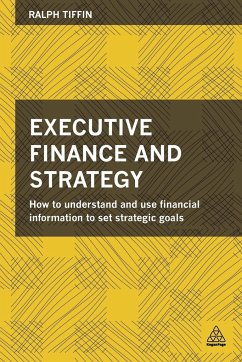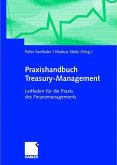Ralph Tiffin
Executive Finance and Strategy
How to Understand and Use Financial Information to Set Strategic Goals
Ralph Tiffin
Executive Finance and Strategy
How to Understand and Use Financial Information to Set Strategic Goals
- Broschiertes Buch
- Merkliste
- Auf die Merkliste
- Bewerten Bewerten
- Teilen
- Produkt teilen
- Produkterinnerung
- Produkterinnerung
Many strategies are explained as actions that will achieve the desired goals or visions of the company, but in order to predict the success of your strategy it is vital to gain an understanding of how it will impact on the financial statement. Executive Finance and Strategy works on the premise that financial models can clearly demonstrate where a particular strategy might lead, enabling you to evaluate past accounts and statements in order to respond to recent company history. It also explains how company law and ethics underpin financial statements and clarifies your responsibilities as a…mehr
Andere Kunden interessierten sich auch für
![International Financial Management International Financial Management]() Geert BekaertInternational Financial Management82,99 €
Geert BekaertInternational Financial Management82,99 €![Reinventing Financial Regulation Reinventing Financial Regulation]() Avinash PersaudReinventing Financial Regulation27,99 €
Avinash PersaudReinventing Financial Regulation27,99 €![Portfolio Strategies of Private Equity Firms Portfolio Strategies of Private Equity Firms]() Ulrich LossenPortfolio Strategies of Private Equity Firms53,49 €
Ulrich LossenPortfolio Strategies of Private Equity Firms53,49 €![Praxishandbuch Treasury-Management Praxishandbuch Treasury-Management]() Markus Steitz / Peter Seethaler (Hgg.)Praxishandbuch Treasury-Management119,99 €
Markus Steitz / Peter Seethaler (Hgg.)Praxishandbuch Treasury-Management119,99 €![So bauen Sie ein profitables Unternehmen So bauen Sie ein profitables Unternehmen]() Philip SemmelrothSo bauen Sie ein profitables Unternehmen29,90 €
Philip SemmelrothSo bauen Sie ein profitables Unternehmen29,90 €![Credit-Risk Modelling Credit-Risk Modelling]() David Jamieson BolderCredit-Risk Modelling68,99 €
David Jamieson BolderCredit-Risk Modelling68,99 €![Finance Transformation Finance Transformation]() Frank Keuper / Fritz Neumann (Hrsg.)Finance Transformation79,99 €
Frank Keuper / Fritz Neumann (Hrsg.)Finance Transformation79,99 €-
-
-
Many strategies are explained as actions that will achieve the desired goals or visions of the company, but in order to predict the success of your strategy it is vital to gain an understanding of how it will impact on the financial statement. Executive Finance and Strategy works on the premise that financial models can clearly demonstrate where a particular strategy might lead, enabling you to evaluate past accounts and statements in order to respond to recent company history. It also explains how company law and ethics underpin financial statements and clarifies your responsibilities as a senior manager or director. By using finance as a record keeper and predictor of success, it helps you quantify your strategy to gain support from colleagues and take the right actions to ensure sustainable growth. Online supporting resources for this book include tables and formulas to support financial models within the book.
Hinweis: Dieser Artikel kann nur an eine deutsche Lieferadresse ausgeliefert werden.
Hinweis: Dieser Artikel kann nur an eine deutsche Lieferadresse ausgeliefert werden.
Produktdetails
- Produktdetails
- Verlag: Kogan Page
- Seitenzahl: 346
- Erscheinungstermin: 1. September 2014
- Englisch
- Abmessung: 234mm x 156mm x 19mm
- Gewicht: 526g
- ISBN-13: 9780749471507
- ISBN-10: 0749471506
- Artikelnr.: 40788002
- Herstellerkennzeichnung
- Libri GmbH
- Europaallee 1
- 36244 Bad Hersfeld
- gpsr@libri.de
- Verlag: Kogan Page
- Seitenzahl: 346
- Erscheinungstermin: 1. September 2014
- Englisch
- Abmessung: 234mm x 156mm x 19mm
- Gewicht: 526g
- ISBN-13: 9780749471507
- ISBN-10: 0749471506
- Artikelnr.: 40788002
- Herstellerkennzeichnung
- Libri GmbH
- Europaallee 1
- 36244 Bad Hersfeld
- gpsr@libri.de
Ralph Tiffin is Director of Tiffins.com training and consulting company, and he is principal of McLachlan+Tiffin, which focuses on auditing while also advising clients on budgeting, project appraisal IFRS, ethics and fraud prevention. His clients include BT, Bank of China, Telekom Malaysia and Deutsche Bank. He is author of a range of texts on financial management, accounting and auditing.
Introduction
01 What is strategy? What does financial strategy mean?
Content, order and logic of this chapter
Definitions of 'financial', 'strategy' and 'strategic'
Further strategy-related definitions
What is business strategy?
What is the objective of financial strategy?
Why be in business?
Conclusion
02 Financial strategy: why be in business?
Content, order and logic of this chapter
What do successful companies say?
How does making a return on investment link with strategy?
What successful companies say
Making a good return is the objective, but what exactly is ROI?
Strategic drivers of ROI
Conclusion
Revision and learning pointers
03 Basic financial reports and concepts
Content, order and logic of this chapter
The importance of cash records and reports
Bedrock concepts
Income statement - the P&L account
Statement of financial position - the balance sheet
Conclusion
Revision and learning pointers
04 What underpins financial statements?
Content, order and logic of this chapter
Company law and directors' responsibilities
Record keeping/bookkeeping
Internal controls - accounting systems and procedures - prevention of error
and fraud
External and internal audit - prevention of error and fraud
Corporate governance
Conclusion
Revision and learning pointers
05 Accounting 'rules': how accounting theory and rules affect the strategic
numbers
Content, order and logic of this chapter
Background to accounting standards
What do GAAP, FASB, IASB and IFRS mean?
Principal accounting concepts - going concern and accruals
How the concepts impact on the figures (and restrain some behaviour)
GAAP, which may cause issues with strategies
Conclusion
Revision and learning pointers
Appendix
06 Published or statutory accounts
Content, order and logic of this chapter
What extant accounting standards require
Balance sheets - statements of financial position
Notes to financial statements
UK full financial statements
Developments in financial reporting
The strategic report
Future developments
Conclusion
Revision and learning pointers
07 Interpreting financial statements
Content, order and logic of this chapter
Techniques for interpreting financial statements
Ratio analysis
Working capital ratios
Analytical review
External ratios
Why we have to disclose ratios
Conclusion
Revision and learning pointers
08 Cash: the vital element
Content, order and logic of this chapter
Where cash appears in financial statements
Cash flows for trading - working capital
Insolvency - going concern - overtrading
Capital cash flows
Statement of cash flows
Cash-flow-focused strategies
Conclusion
Revision and learning pointers
09 Management accounting: internal reports and business models
Content, order and logic of this chapter
The wide scope of management accounting
Cautionary words on modelling
Management reports - to assist with understanding strategy and its delivery
Sales and costing definitions and models
KPIs, dashboards and detailed analysis
Analytics - can there be too much analysis?
Conclusion
Revision and learning pointers
10 Budgeting
Content, order and logic of this chapter
What does budgeting mean?
Forecasting methods
Why budget?
Methods of budgeting
Budget culture
Conclusion
Revision and learning pointers
11 Investment appraisal: investment strategy
Content, order and logic of this chapter
The need for investment appraisal
The time value of money and required rates
Cash flow models
Common appraisal measures
Risk identification and management
How much analysis should be carried out?
The need for a consistent and robust process
The many uses of appraisal models
Conclusion
Revision and learning pointers
12 Structural or pure financial strategies
Content, order and logic of this chapter
Basic definitions
Gearing or leverage and the 'magic' of gearing
Leasing and off-balance sheet finance
Group structures
Special purpose vehicles or entities - off balance sheet activities
Foreign currency issues
Hedging strategies
Conclusion
Revision and learning pointers
13 Summary
What are your company objectives - where do you fit in?
Strategies both financial and physical to support objectives
Links between the book's chapters and strategies
Are your strategies coordinated and aligned?
Aphorisms
Glossary
References
Index
01 What is strategy? What does financial strategy mean?
Content, order and logic of this chapter
Definitions of 'financial', 'strategy' and 'strategic'
Further strategy-related definitions
What is business strategy?
What is the objective of financial strategy?
Why be in business?
Conclusion
02 Financial strategy: why be in business?
Content, order and logic of this chapter
What do successful companies say?
How does making a return on investment link with strategy?
What successful companies say
Making a good return is the objective, but what exactly is ROI?
Strategic drivers of ROI
Conclusion
Revision and learning pointers
03 Basic financial reports and concepts
Content, order and logic of this chapter
The importance of cash records and reports
Bedrock concepts
Income statement - the P&L account
Statement of financial position - the balance sheet
Conclusion
Revision and learning pointers
04 What underpins financial statements?
Content, order and logic of this chapter
Company law and directors' responsibilities
Record keeping/bookkeeping
Internal controls - accounting systems and procedures - prevention of error
and fraud
External and internal audit - prevention of error and fraud
Corporate governance
Conclusion
Revision and learning pointers
05 Accounting 'rules': how accounting theory and rules affect the strategic
numbers
Content, order and logic of this chapter
Background to accounting standards
What do GAAP, FASB, IASB and IFRS mean?
Principal accounting concepts - going concern and accruals
How the concepts impact on the figures (and restrain some behaviour)
GAAP, which may cause issues with strategies
Conclusion
Revision and learning pointers
Appendix
06 Published or statutory accounts
Content, order and logic of this chapter
What extant accounting standards require
Balance sheets - statements of financial position
Notes to financial statements
UK full financial statements
Developments in financial reporting
The strategic report
Future developments
Conclusion
Revision and learning pointers
07 Interpreting financial statements
Content, order and logic of this chapter
Techniques for interpreting financial statements
Ratio analysis
Working capital ratios
Analytical review
External ratios
Why we have to disclose ratios
Conclusion
Revision and learning pointers
08 Cash: the vital element
Content, order and logic of this chapter
Where cash appears in financial statements
Cash flows for trading - working capital
Insolvency - going concern - overtrading
Capital cash flows
Statement of cash flows
Cash-flow-focused strategies
Conclusion
Revision and learning pointers
09 Management accounting: internal reports and business models
Content, order and logic of this chapter
The wide scope of management accounting
Cautionary words on modelling
Management reports - to assist with understanding strategy and its delivery
Sales and costing definitions and models
KPIs, dashboards and detailed analysis
Analytics - can there be too much analysis?
Conclusion
Revision and learning pointers
10 Budgeting
Content, order and logic of this chapter
What does budgeting mean?
Forecasting methods
Why budget?
Methods of budgeting
Budget culture
Conclusion
Revision and learning pointers
11 Investment appraisal: investment strategy
Content, order and logic of this chapter
The need for investment appraisal
The time value of money and required rates
Cash flow models
Common appraisal measures
Risk identification and management
How much analysis should be carried out?
The need for a consistent and robust process
The many uses of appraisal models
Conclusion
Revision and learning pointers
12 Structural or pure financial strategies
Content, order and logic of this chapter
Basic definitions
Gearing or leverage and the 'magic' of gearing
Leasing and off-balance sheet finance
Group structures
Special purpose vehicles or entities - off balance sheet activities
Foreign currency issues
Hedging strategies
Conclusion
Revision and learning pointers
13 Summary
What are your company objectives - where do you fit in?
Strategies both financial and physical to support objectives
Links between the book's chapters and strategies
Are your strategies coordinated and aligned?
Aphorisms
Glossary
References
Index
Introduction
01 What is strategy? What does financial strategy mean?
Content, order and logic of this chapter
Definitions of 'financial', 'strategy' and 'strategic'
Further strategy-related definitions
What is business strategy?
What is the objective of financial strategy?
Why be in business?
Conclusion
02 Financial strategy: why be in business?
Content, order and logic of this chapter
What do successful companies say?
How does making a return on investment link with strategy?
What successful companies say
Making a good return is the objective, but what exactly is ROI?
Strategic drivers of ROI
Conclusion
Revision and learning pointers
03 Basic financial reports and concepts
Content, order and logic of this chapter
The importance of cash records and reports
Bedrock concepts
Income statement - the P&L account
Statement of financial position - the balance sheet
Conclusion
Revision and learning pointers
04 What underpins financial statements?
Content, order and logic of this chapter
Company law and directors' responsibilities
Record keeping/bookkeeping
Internal controls - accounting systems and procedures - prevention of error
and fraud
External and internal audit - prevention of error and fraud
Corporate governance
Conclusion
Revision and learning pointers
05 Accounting 'rules': how accounting theory and rules affect the strategic
numbers
Content, order and logic of this chapter
Background to accounting standards
What do GAAP, FASB, IASB and IFRS mean?
Principal accounting concepts - going concern and accruals
How the concepts impact on the figures (and restrain some behaviour)
GAAP, which may cause issues with strategies
Conclusion
Revision and learning pointers
Appendix
06 Published or statutory accounts
Content, order and logic of this chapter
What extant accounting standards require
Balance sheets - statements of financial position
Notes to financial statements
UK full financial statements
Developments in financial reporting
The strategic report
Future developments
Conclusion
Revision and learning pointers
07 Interpreting financial statements
Content, order and logic of this chapter
Techniques for interpreting financial statements
Ratio analysis
Working capital ratios
Analytical review
External ratios
Why we have to disclose ratios
Conclusion
Revision and learning pointers
08 Cash: the vital element
Content, order and logic of this chapter
Where cash appears in financial statements
Cash flows for trading - working capital
Insolvency - going concern - overtrading
Capital cash flows
Statement of cash flows
Cash-flow-focused strategies
Conclusion
Revision and learning pointers
09 Management accounting: internal reports and business models
Content, order and logic of this chapter
The wide scope of management accounting
Cautionary words on modelling
Management reports - to assist with understanding strategy and its delivery
Sales and costing definitions and models
KPIs, dashboards and detailed analysis
Analytics - can there be too much analysis?
Conclusion
Revision and learning pointers
10 Budgeting
Content, order and logic of this chapter
What does budgeting mean?
Forecasting methods
Why budget?
Methods of budgeting
Budget culture
Conclusion
Revision and learning pointers
11 Investment appraisal: investment strategy
Content, order and logic of this chapter
The need for investment appraisal
The time value of money and required rates
Cash flow models
Common appraisal measures
Risk identification and management
How much analysis should be carried out?
The need for a consistent and robust process
The many uses of appraisal models
Conclusion
Revision and learning pointers
12 Structural or pure financial strategies
Content, order and logic of this chapter
Basic definitions
Gearing or leverage and the 'magic' of gearing
Leasing and off-balance sheet finance
Group structures
Special purpose vehicles or entities - off balance sheet activities
Foreign currency issues
Hedging strategies
Conclusion
Revision and learning pointers
13 Summary
What are your company objectives - where do you fit in?
Strategies both financial and physical to support objectives
Links between the book's chapters and strategies
Are your strategies coordinated and aligned?
Aphorisms
Glossary
References
Index
01 What is strategy? What does financial strategy mean?
Content, order and logic of this chapter
Definitions of 'financial', 'strategy' and 'strategic'
Further strategy-related definitions
What is business strategy?
What is the objective of financial strategy?
Why be in business?
Conclusion
02 Financial strategy: why be in business?
Content, order and logic of this chapter
What do successful companies say?
How does making a return on investment link with strategy?
What successful companies say
Making a good return is the objective, but what exactly is ROI?
Strategic drivers of ROI
Conclusion
Revision and learning pointers
03 Basic financial reports and concepts
Content, order and logic of this chapter
The importance of cash records and reports
Bedrock concepts
Income statement - the P&L account
Statement of financial position - the balance sheet
Conclusion
Revision and learning pointers
04 What underpins financial statements?
Content, order and logic of this chapter
Company law and directors' responsibilities
Record keeping/bookkeeping
Internal controls - accounting systems and procedures - prevention of error
and fraud
External and internal audit - prevention of error and fraud
Corporate governance
Conclusion
Revision and learning pointers
05 Accounting 'rules': how accounting theory and rules affect the strategic
numbers
Content, order and logic of this chapter
Background to accounting standards
What do GAAP, FASB, IASB and IFRS mean?
Principal accounting concepts - going concern and accruals
How the concepts impact on the figures (and restrain some behaviour)
GAAP, which may cause issues with strategies
Conclusion
Revision and learning pointers
Appendix
06 Published or statutory accounts
Content, order and logic of this chapter
What extant accounting standards require
Balance sheets - statements of financial position
Notes to financial statements
UK full financial statements
Developments in financial reporting
The strategic report
Future developments
Conclusion
Revision and learning pointers
07 Interpreting financial statements
Content, order and logic of this chapter
Techniques for interpreting financial statements
Ratio analysis
Working capital ratios
Analytical review
External ratios
Why we have to disclose ratios
Conclusion
Revision and learning pointers
08 Cash: the vital element
Content, order and logic of this chapter
Where cash appears in financial statements
Cash flows for trading - working capital
Insolvency - going concern - overtrading
Capital cash flows
Statement of cash flows
Cash-flow-focused strategies
Conclusion
Revision and learning pointers
09 Management accounting: internal reports and business models
Content, order and logic of this chapter
The wide scope of management accounting
Cautionary words on modelling
Management reports - to assist with understanding strategy and its delivery
Sales and costing definitions and models
KPIs, dashboards and detailed analysis
Analytics - can there be too much analysis?
Conclusion
Revision and learning pointers
10 Budgeting
Content, order and logic of this chapter
What does budgeting mean?
Forecasting methods
Why budget?
Methods of budgeting
Budget culture
Conclusion
Revision and learning pointers
11 Investment appraisal: investment strategy
Content, order and logic of this chapter
The need for investment appraisal
The time value of money and required rates
Cash flow models
Common appraisal measures
Risk identification and management
How much analysis should be carried out?
The need for a consistent and robust process
The many uses of appraisal models
Conclusion
Revision and learning pointers
12 Structural or pure financial strategies
Content, order and logic of this chapter
Basic definitions
Gearing or leverage and the 'magic' of gearing
Leasing and off-balance sheet finance
Group structures
Special purpose vehicles or entities - off balance sheet activities
Foreign currency issues
Hedging strategies
Conclusion
Revision and learning pointers
13 Summary
What are your company objectives - where do you fit in?
Strategies both financial and physical to support objectives
Links between the book's chapters and strategies
Are your strategies coordinated and aligned?
Aphorisms
Glossary
References
Index








